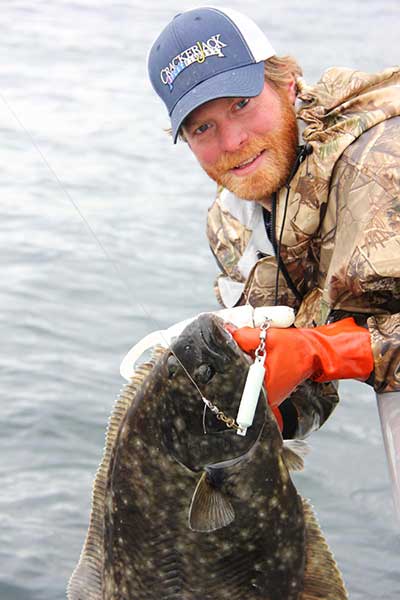Alaska Fish & Wildlife News
July 2015
Every Halibut Counts

Alaskans and visitors alike love to catch halibut and take them home to eat. Since 2010 charter boat anglers in Southeast and Southcentral Alaska have landed 2.3 to 3.8 million pounds per year of the tasty flatfish, which is in addition to 2.3-2.8 million pounds per year of non-guided angler harvest.
But anglers released about 40-45 percent of all halibut they caught. Many anglers release halibut that are either smaller than preferred, or too small or too large to keep under existing limits. Or they may continue to catch and release halibut after they’ve taken their bag limit. Some people release the biggest fish, which are mostly highly productive females, in the belief that doing so contributes to resource conservation.
The halibut is a hardy fish. Lacking a swim bladder, it doesn’t suffer barotrauma—the protrusion of eyes and internal organs—that can kill rockfish and cod when brought up from the deep. Most halibut landed by anglers and subsequently released survive to grow and fight another day. But a few do not, victims of gut- or gill hooking, or of rough handling. Starting in 2014, the allocation to charter halibut anglers includes the estimated release mortality, which adds another 2-3 percent to the overall harvest by weight.
In 2013 two fishing charter operators contacted the Alaska Marine Conservation Council and proposed drafting a set of voluntary best practices for release of sport-caught halibut, and circulating the information to charter boat crews, their clients, and non-guided anglers. They believed that improved practices would result in better halibut conservation and would increase recognition of stewardship in their industry
AMCC director Kelly Harrell obtained funding from the National Fish and Wildlife Foundation, and asked the Alaska Sea Grant Marine Advisory Program to help develop the project, which became known as Every Halibut Counts.

First we recruited six charter captains to volunteer on a steering committee. They were joined by staff from Alaska Dept. of Fish and Game and the International Pacific Halibut Commission. During committee meetings the captains proposed practices that they knew were practical, effective for minimizing release mortality, and would impose minimal burden on the vessels and crews. We circulated the drafts for review and took them to meetings in various ports for broader industry input.
The underlying principle of Every Halibut Counts is simple: treat each fish to be released gently and respectfully to maximize its chances of survival. The specifics are equally simple:
- Decide quickly whether to release a fish, preferably while it’s still in the water.
- Have an unhooking device like a rod with curved end or gaff ready to release the hook with a quick push and twist motion.
- If the fish is too big or gut hooked, cut the leader as close to the hook as possible. Hooks will corrode and eventually fall out.
- If you must bring a fish into the boat to measure it or to roll the hook out by hand, cradle it with both hands and prevent it from hitting sharp objects in the boat. Never lift a fish only by the tail or gills—always cradle with the other hand.
- Slip the fish gently back into the water head-first. Don’t “throw back” a fish.
Here are a few more tips:
Circle hooks are easy to remove and cause less damage to halibut than J hooks or treble hooks. Barbless circle hooks hold halibut almost as well as those with barbs, and are even less damaging to remove.

Reel in fish quickly to minimize exhaustion. If you anticipate bringing fish on board that you intend to release, designate a place on deck for handling that has no pointed or sharp edges, and place fish on a mat or padding for handling
If a fish is bleeding, gut hooked or visibly injured it probably won’t survive. Keep it and count it against your bag limit if it doesn’t violate size or bag limits.
Avoid the “chicken patch” and if you find you’re catching a lot of fish smaller than what you want to keep, move on. The fewer halibut caught and released, the fewer that die of hooking and handling injuries.
Keep a count of the number of halibut you release each day and enter numbers in your fishing journal.
Be a role model. Encourage others to catch only what they want to keep, and treat every fish with respect.
The Every Halibut Counts project has two websites, a seven-minute video narrated by Wicked Tuna reality show star Capt. Dave Marciano. Brochures, stickers, and laminated placards for posting in boat cabin windows are also available. Project members have staffed booths in outdoor sport shows around the state, conducted port meetings, and published articles in fishing publications and coastal town newsletters. Response from the public and industry has been overwhelmingly supportive, and more than 50 charter boats now proudly display the EHC placard.
For more information, see http://seagrant.uaf.edu/map/recreation/halibut-release/index.html.
Terry Johnson is a professor of fisheries and a marine advisory agent with the Alaska Sea Grant Marine Advisory Program, based in Anchorage.
Subscribe to be notified about new issues
Receive a monthly notice about new issues and articles.
